Leadership, Culture & Professional Learning in Educational Settings
VerifiedAdded on 2023/05/27
|15
|4029
|147
Report
AI Summary
This report provides an overview of school leadership, its various types, the significance of school culture, and the importance of teachers' professional learning. It explores concepts like distributed leadership and instructional leadership, highlighting their impact on school improvement and teacher development. The report emphasizes the need for leaders to foster a learning-focused environment, prioritize dialogue, and promote shared leadership to achieve the primary goal of education. It also discusses the constraints faced by school leaders and the importance of adapting leadership models to suit the specific needs of the school environment. The document concludes by highlighting the critical role of leadership in shaping school culture and enhancing teachers' professional growth, enabling them to effectively contribute to student learning and overall school success. Desklib offers a variety of resources and solved assignments for students seeking further information on these topics.

Running Head: LEADERSHIP, CULTURE AND PROFESSIONAL LEARNING 1
School Leadership and School Culture and Teachers’ Professional Learning
NAME
UNIVERSITY/AFFILIATION
COURSE
School Leadership and School Culture and Teachers’ Professional Learning
NAME
UNIVERSITY/AFFILIATION
COURSE
Paraphrase This Document
Need a fresh take? Get an instant paraphrase of this document with our AI Paraphraser
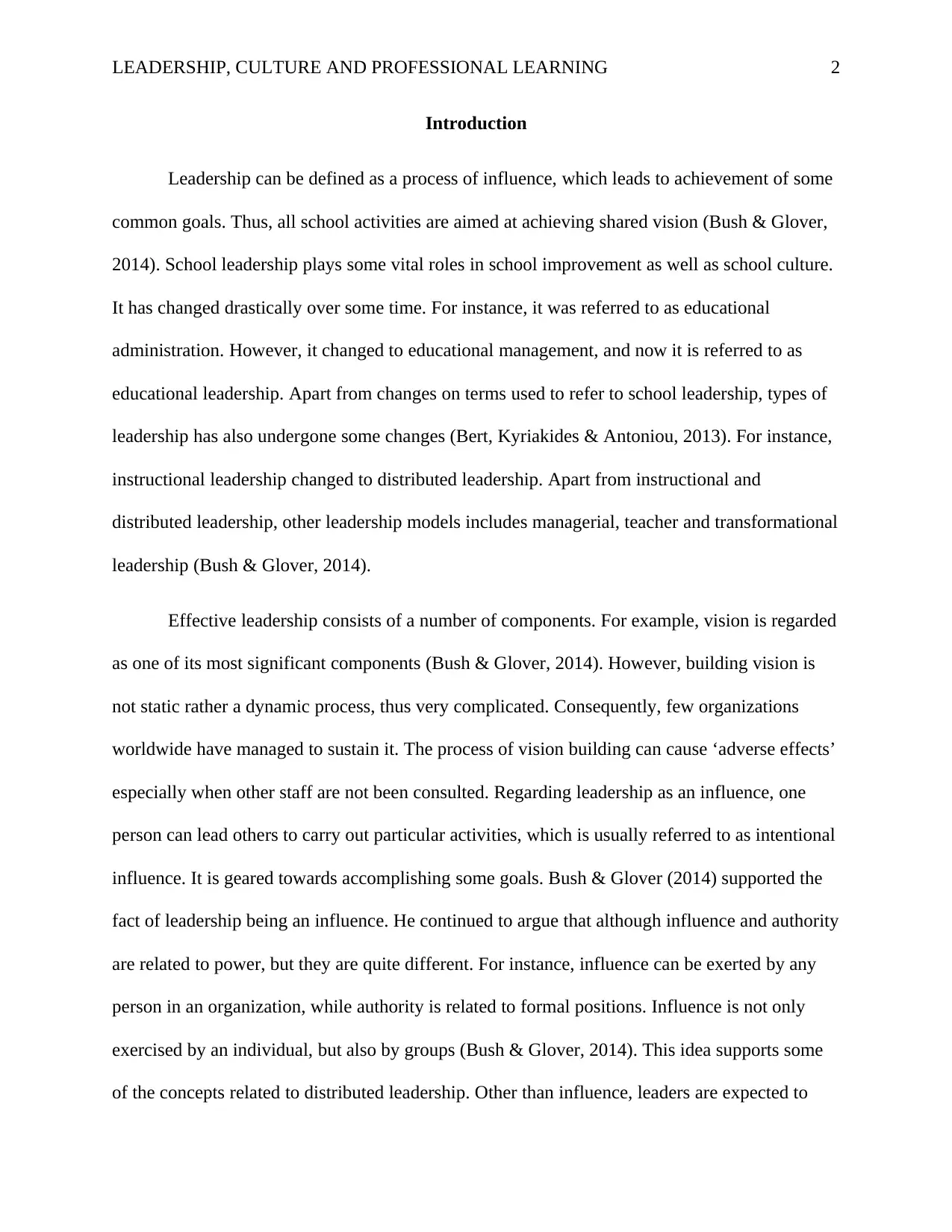
LEADERSHIP, CULTURE AND PROFESSIONAL LEARNING 2
Introduction
Leadership can be defined as a process of influence, which leads to achievement of some
common goals. Thus, all school activities are aimed at achieving shared vision (Bush & Glover,
2014). School leadership plays some vital roles in school improvement as well as school culture.
It has changed drastically over some time. For instance, it was referred to as educational
administration. However, it changed to educational management, and now it is referred to as
educational leadership. Apart from changes on terms used to refer to school leadership, types of
leadership has also undergone some changes (Bert, Kyriakides & Antoniou, 2013). For instance,
instructional leadership changed to distributed leadership. Apart from instructional and
distributed leadership, other leadership models includes managerial, teacher and transformational
leadership (Bush & Glover, 2014).
Effective leadership consists of a number of components. For example, vision is regarded
as one of its most significant components (Bush & Glover, 2014). However, building vision is
not static rather a dynamic process, thus very complicated. Consequently, few organizations
worldwide have managed to sustain it. The process of vision building can cause ‘adverse effects’
especially when other staff are not been consulted. Regarding leadership as an influence, one
person can lead others to carry out particular activities, which is usually referred to as intentional
influence. It is geared towards accomplishing some goals. Bush & Glover (2014) supported the
fact of leadership being an influence. He continued to argue that although influence and authority
are related to power, but they are quite different. For instance, influence can be exerted by any
person in an organization, while authority is related to formal positions. Influence is not only
exercised by an individual, but also by groups (Bush & Glover, 2014). This idea supports some
of the concepts related to distributed leadership. Other than influence, leaders are expected to
Introduction
Leadership can be defined as a process of influence, which leads to achievement of some
common goals. Thus, all school activities are aimed at achieving shared vision (Bush & Glover,
2014). School leadership plays some vital roles in school improvement as well as school culture.
It has changed drastically over some time. For instance, it was referred to as educational
administration. However, it changed to educational management, and now it is referred to as
educational leadership. Apart from changes on terms used to refer to school leadership, types of
leadership has also undergone some changes (Bert, Kyriakides & Antoniou, 2013). For instance,
instructional leadership changed to distributed leadership. Apart from instructional and
distributed leadership, other leadership models includes managerial, teacher and transformational
leadership (Bush & Glover, 2014).
Effective leadership consists of a number of components. For example, vision is regarded
as one of its most significant components (Bush & Glover, 2014). However, building vision is
not static rather a dynamic process, thus very complicated. Consequently, few organizations
worldwide have managed to sustain it. The process of vision building can cause ‘adverse effects’
especially when other staff are not been consulted. Regarding leadership as an influence, one
person can lead others to carry out particular activities, which is usually referred to as intentional
influence. It is geared towards accomplishing some goals. Bush & Glover (2014) supported the
fact of leadership being an influence. He continued to argue that although influence and authority
are related to power, but they are quite different. For instance, influence can be exerted by any
person in an organization, while authority is related to formal positions. Influence is not only
exercised by an individual, but also by groups (Bush & Glover, 2014). This idea supports some
of the concepts related to distributed leadership. Other than influence, leaders are expected to
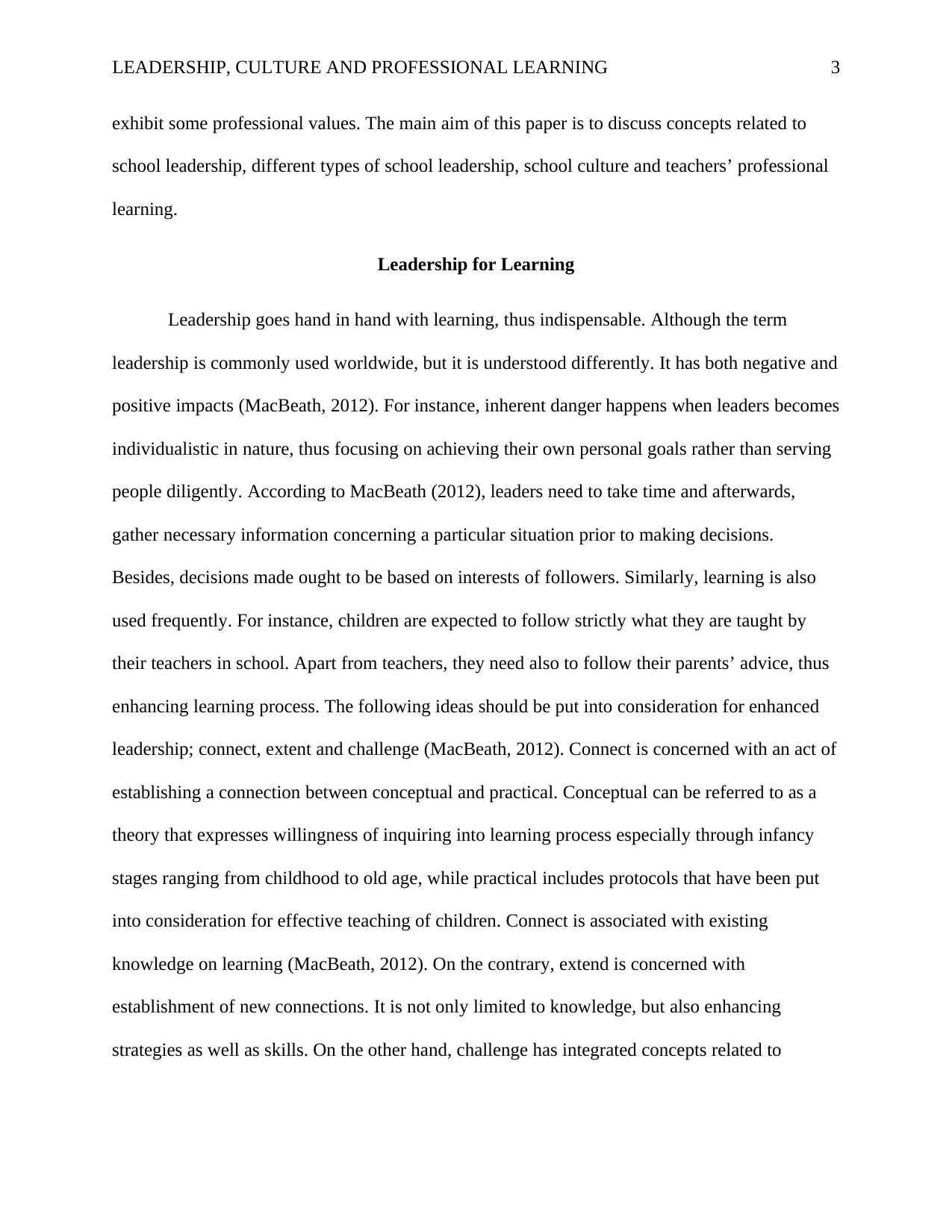
LEADERSHIP, CULTURE AND PROFESSIONAL LEARNING 3
exhibit some professional values. The main aim of this paper is to discuss concepts related to
school leadership, different types of school leadership, school culture and teachers’ professional
learning.
Leadership for Learning
Leadership goes hand in hand with learning, thus indispensable. Although the term
leadership is commonly used worldwide, but it is understood differently. It has both negative and
positive impacts (MacBeath, 2012). For instance, inherent danger happens when leaders becomes
individualistic in nature, thus focusing on achieving their own personal goals rather than serving
people diligently. According to MacBeath (2012), leaders need to take time and afterwards,
gather necessary information concerning a particular situation prior to making decisions.
Besides, decisions made ought to be based on interests of followers. Similarly, learning is also
used frequently. For instance, children are expected to follow strictly what they are taught by
their teachers in school. Apart from teachers, they need also to follow their parents’ advice, thus
enhancing learning process. The following ideas should be put into consideration for enhanced
leadership; connect, extent and challenge (MacBeath, 2012). Connect is concerned with an act of
establishing a connection between conceptual and practical. Conceptual can be referred to as a
theory that expresses willingness of inquiring into learning process especially through infancy
stages ranging from childhood to old age, while practical includes protocols that have been put
into consideration for effective teaching of children. Connect is associated with existing
knowledge on learning (MacBeath, 2012). On the contrary, extend is concerned with
establishment of new connections. It is not only limited to knowledge, but also enhancing
strategies as well as skills. On the other hand, challenge has integrated concepts related to
exhibit some professional values. The main aim of this paper is to discuss concepts related to
school leadership, different types of school leadership, school culture and teachers’ professional
learning.
Leadership for Learning
Leadership goes hand in hand with learning, thus indispensable. Although the term
leadership is commonly used worldwide, but it is understood differently. It has both negative and
positive impacts (MacBeath, 2012). For instance, inherent danger happens when leaders becomes
individualistic in nature, thus focusing on achieving their own personal goals rather than serving
people diligently. According to MacBeath (2012), leaders need to take time and afterwards,
gather necessary information concerning a particular situation prior to making decisions.
Besides, decisions made ought to be based on interests of followers. Similarly, learning is also
used frequently. For instance, children are expected to follow strictly what they are taught by
their teachers in school. Apart from teachers, they need also to follow their parents’ advice, thus
enhancing learning process. The following ideas should be put into consideration for enhanced
leadership; connect, extent and challenge (MacBeath, 2012). Connect is concerned with an act of
establishing a connection between conceptual and practical. Conceptual can be referred to as a
theory that expresses willingness of inquiring into learning process especially through infancy
stages ranging from childhood to old age, while practical includes protocols that have been put
into consideration for effective teaching of children. Connect is associated with existing
knowledge on learning (MacBeath, 2012). On the contrary, extend is concerned with
establishment of new connections. It is not only limited to knowledge, but also enhancing
strategies as well as skills. On the other hand, challenge has integrated concepts related to
⊘ This is a preview!⊘
Do you want full access?
Subscribe today to unlock all pages.

Trusted by 1+ million students worldwide
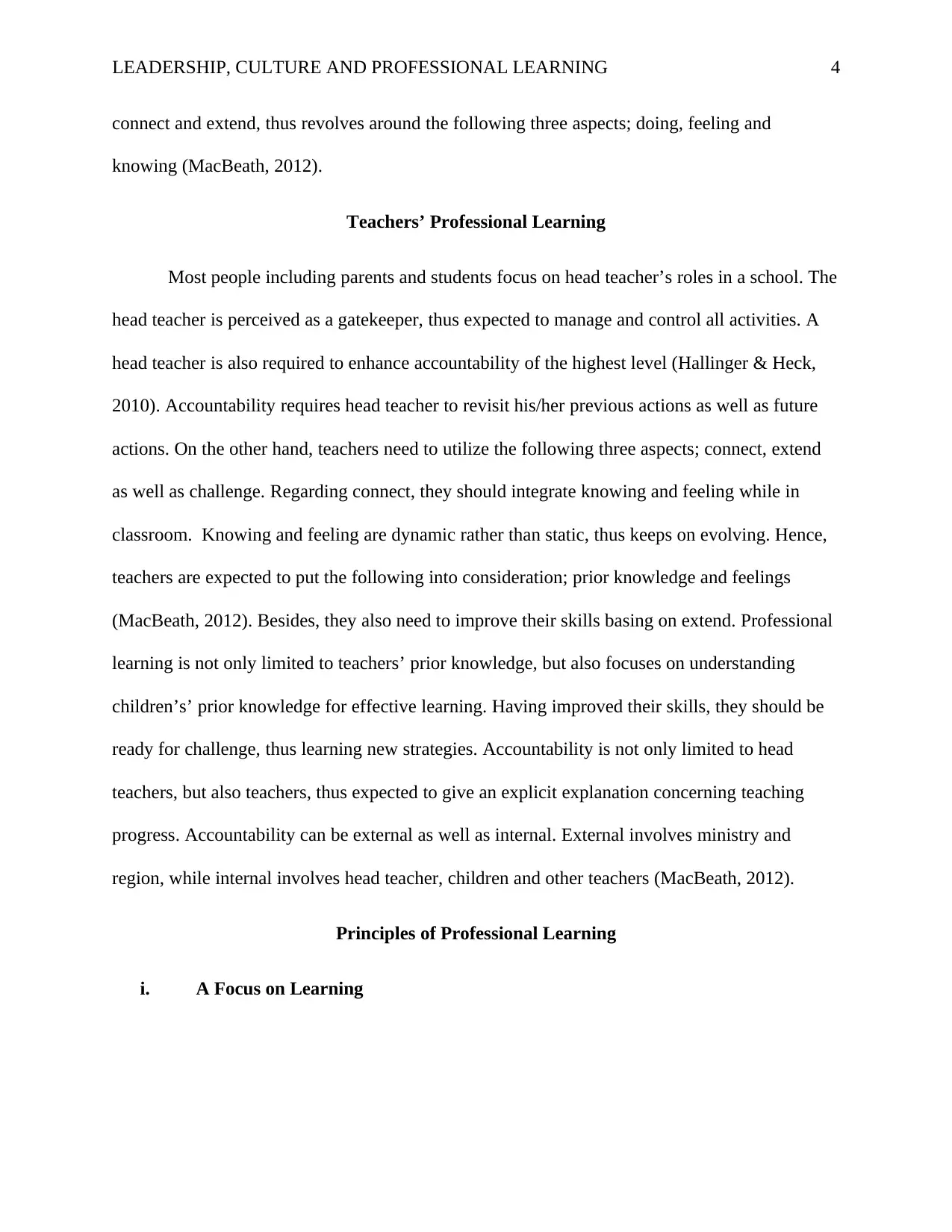
LEADERSHIP, CULTURE AND PROFESSIONAL LEARNING 4
connect and extend, thus revolves around the following three aspects; doing, feeling and
knowing (MacBeath, 2012).
Teachers’ Professional Learning
Most people including parents and students focus on head teacher’s roles in a school. The
head teacher is perceived as a gatekeeper, thus expected to manage and control all activities. A
head teacher is also required to enhance accountability of the highest level (Hallinger & Heck,
2010). Accountability requires head teacher to revisit his/her previous actions as well as future
actions. On the other hand, teachers need to utilize the following three aspects; connect, extend
as well as challenge. Regarding connect, they should integrate knowing and feeling while in
classroom. Knowing and feeling are dynamic rather than static, thus keeps on evolving. Hence,
teachers are expected to put the following into consideration; prior knowledge and feelings
(MacBeath, 2012). Besides, they also need to improve their skills basing on extend. Professional
learning is not only limited to teachers’ prior knowledge, but also focuses on understanding
children’s’ prior knowledge for effective learning. Having improved their skills, they should be
ready for challenge, thus learning new strategies. Accountability is not only limited to head
teachers, but also teachers, thus expected to give an explicit explanation concerning teaching
progress. Accountability can be external as well as internal. External involves ministry and
region, while internal involves head teacher, children and other teachers (MacBeath, 2012).
Principles of Professional Learning
i. A Focus on Learning
connect and extend, thus revolves around the following three aspects; doing, feeling and
knowing (MacBeath, 2012).
Teachers’ Professional Learning
Most people including parents and students focus on head teacher’s roles in a school. The
head teacher is perceived as a gatekeeper, thus expected to manage and control all activities. A
head teacher is also required to enhance accountability of the highest level (Hallinger & Heck,
2010). Accountability requires head teacher to revisit his/her previous actions as well as future
actions. On the other hand, teachers need to utilize the following three aspects; connect, extend
as well as challenge. Regarding connect, they should integrate knowing and feeling while in
classroom. Knowing and feeling are dynamic rather than static, thus keeps on evolving. Hence,
teachers are expected to put the following into consideration; prior knowledge and feelings
(MacBeath, 2012). Besides, they also need to improve their skills basing on extend. Professional
learning is not only limited to teachers’ prior knowledge, but also focuses on understanding
children’s’ prior knowledge for effective learning. Having improved their skills, they should be
ready for challenge, thus learning new strategies. Accountability is not only limited to head
teachers, but also teachers, thus expected to give an explicit explanation concerning teaching
progress. Accountability can be external as well as internal. External involves ministry and
region, while internal involves head teacher, children and other teachers (MacBeath, 2012).
Principles of Professional Learning
i. A Focus on Learning
Paraphrase This Document
Need a fresh take? Get an instant paraphrase of this document with our AI Paraphraser
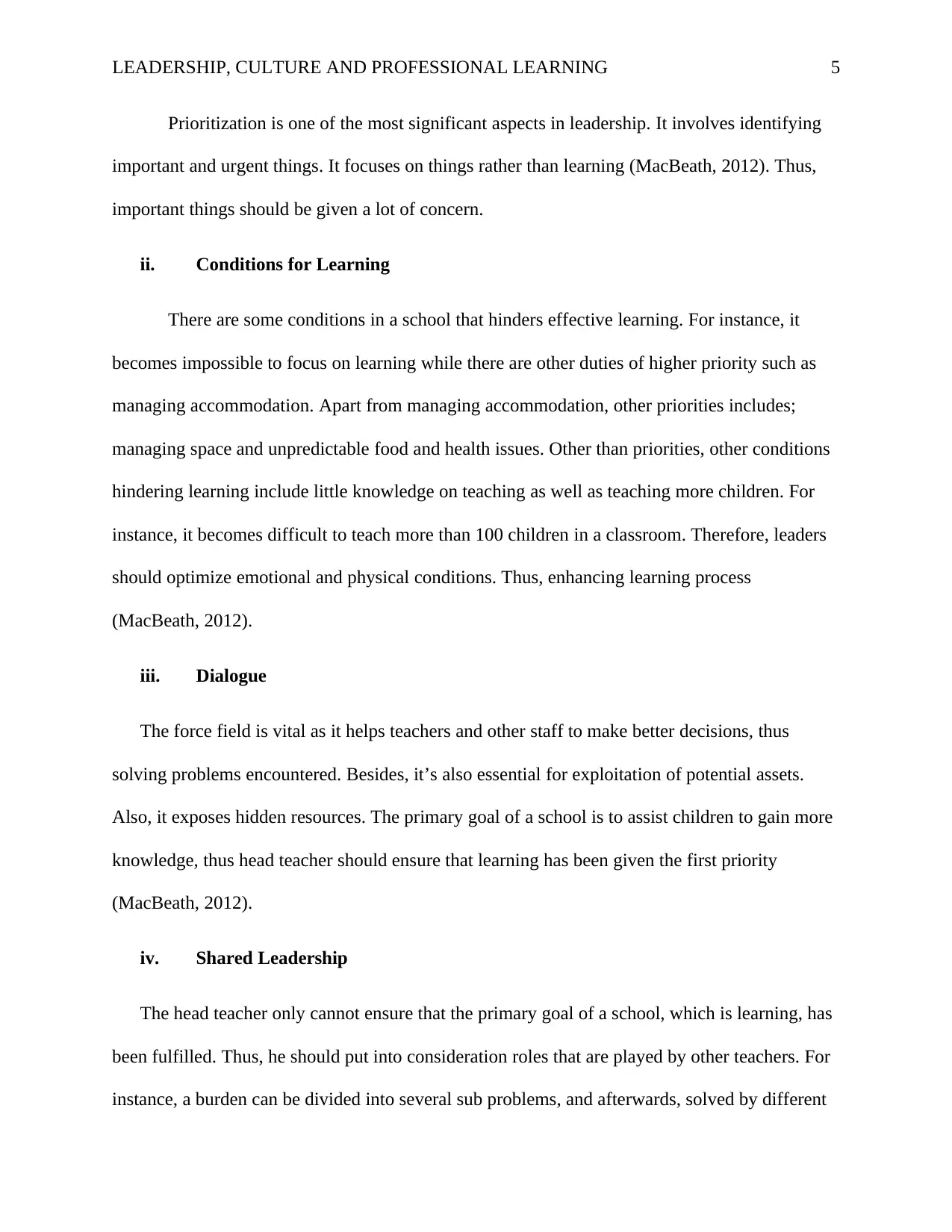
LEADERSHIP, CULTURE AND PROFESSIONAL LEARNING 5
Prioritization is one of the most significant aspects in leadership. It involves identifying
important and urgent things. It focuses on things rather than learning (MacBeath, 2012). Thus,
important things should be given a lot of concern.
ii. Conditions for Learning
There are some conditions in a school that hinders effective learning. For instance, it
becomes impossible to focus on learning while there are other duties of higher priority such as
managing accommodation. Apart from managing accommodation, other priorities includes;
managing space and unpredictable food and health issues. Other than priorities, other conditions
hindering learning include little knowledge on teaching as well as teaching more children. For
instance, it becomes difficult to teach more than 100 children in a classroom. Therefore, leaders
should optimize emotional and physical conditions. Thus, enhancing learning process
(MacBeath, 2012).
iii. Dialogue
The force field is vital as it helps teachers and other staff to make better decisions, thus
solving problems encountered. Besides, it’s also essential for exploitation of potential assets.
Also, it exposes hidden resources. The primary goal of a school is to assist children to gain more
knowledge, thus head teacher should ensure that learning has been given the first priority
(MacBeath, 2012).
iv. Shared Leadership
The head teacher only cannot ensure that the primary goal of a school, which is learning, has
been fulfilled. Thus, he should put into consideration roles that are played by other teachers. For
instance, a burden can be divided into several sub problems, and afterwards, solved by different
Prioritization is one of the most significant aspects in leadership. It involves identifying
important and urgent things. It focuses on things rather than learning (MacBeath, 2012). Thus,
important things should be given a lot of concern.
ii. Conditions for Learning
There are some conditions in a school that hinders effective learning. For instance, it
becomes impossible to focus on learning while there are other duties of higher priority such as
managing accommodation. Apart from managing accommodation, other priorities includes;
managing space and unpredictable food and health issues. Other than priorities, other conditions
hindering learning include little knowledge on teaching as well as teaching more children. For
instance, it becomes difficult to teach more than 100 children in a classroom. Therefore, leaders
should optimize emotional and physical conditions. Thus, enhancing learning process
(MacBeath, 2012).
iii. Dialogue
The force field is vital as it helps teachers and other staff to make better decisions, thus
solving problems encountered. Besides, it’s also essential for exploitation of potential assets.
Also, it exposes hidden resources. The primary goal of a school is to assist children to gain more
knowledge, thus head teacher should ensure that learning has been given the first priority
(MacBeath, 2012).
iv. Shared Leadership
The head teacher only cannot ensure that the primary goal of a school, which is learning, has
been fulfilled. Thus, he should put into consideration roles that are played by other teachers. For
instance, a burden can be divided into several sub problems, and afterwards, solved by different

LEADERSHIP, CULTURE AND PROFESSIONAL LEARNING 6
teachers. This technique is referred to as divide and conquer, thus enhancing shared
responsibility. Also, optimal solutions to a problem or situation can be obtained by bringing
different ideas together. To enhance shared responsibility, there must be trust between head
teacher and teachers (MacBeath, 2012). Trust may in turn reduce unnecessary conflicts, thus
building health relationship among staff members.
Types of Leadership
i. Distributed Leadership
Many types of school leadership models, for example, instructional leadership, focuses
on school principal (Spillane, 2005). However, distributed leadership involves shared
approaches. In 20th century, collegial leadership was widely used. On the contrary, distributed
leadership is the most preferred model in 21st century. This model has grown tremendously as
evidenced from increased scholarly attention. Arguments regarding distributed leadership are
quite different from one scholar to another. For instance, Harris suggests that distributed
leadership involves participation of experts (Spillane, 2005). On the other hand, Spillane (2005)
argues that principal’s role should not be ignored despite involving other teachers in leading
school activities. Besides, Leithwood, Day, Sammons, Harris & Hopkins suggests that
distributed leadership results in greater achievement than individual leadership, thus enhancing
performance (Spillane, 2005).
Distribution as Pragmatic
Distribution plays vital roles in pragmatic, which is related to reaction to government
demands as well as parental pressures. For instance, a task can be effectively completed by one
person. Head teacher allocates or assigns responsibilities to different teachers, thus easing logjam
teachers. This technique is referred to as divide and conquer, thus enhancing shared
responsibility. Also, optimal solutions to a problem or situation can be obtained by bringing
different ideas together. To enhance shared responsibility, there must be trust between head
teacher and teachers (MacBeath, 2012). Trust may in turn reduce unnecessary conflicts, thus
building health relationship among staff members.
Types of Leadership
i. Distributed Leadership
Many types of school leadership models, for example, instructional leadership, focuses
on school principal (Spillane, 2005). However, distributed leadership involves shared
approaches. In 20th century, collegial leadership was widely used. On the contrary, distributed
leadership is the most preferred model in 21st century. This model has grown tremendously as
evidenced from increased scholarly attention. Arguments regarding distributed leadership are
quite different from one scholar to another. For instance, Harris suggests that distributed
leadership involves participation of experts (Spillane, 2005). On the other hand, Spillane (2005)
argues that principal’s role should not be ignored despite involving other teachers in leading
school activities. Besides, Leithwood, Day, Sammons, Harris & Hopkins suggests that
distributed leadership results in greater achievement than individual leadership, thus enhancing
performance (Spillane, 2005).
Distribution as Pragmatic
Distribution plays vital roles in pragmatic, which is related to reaction to government
demands as well as parental pressures. For instance, a task can be effectively completed by one
person. Head teacher allocates or assigns responsibilities to different teachers, thus easing logjam
⊘ This is a preview!⊘
Do you want full access?
Subscribe today to unlock all pages.

Trusted by 1+ million students worldwide
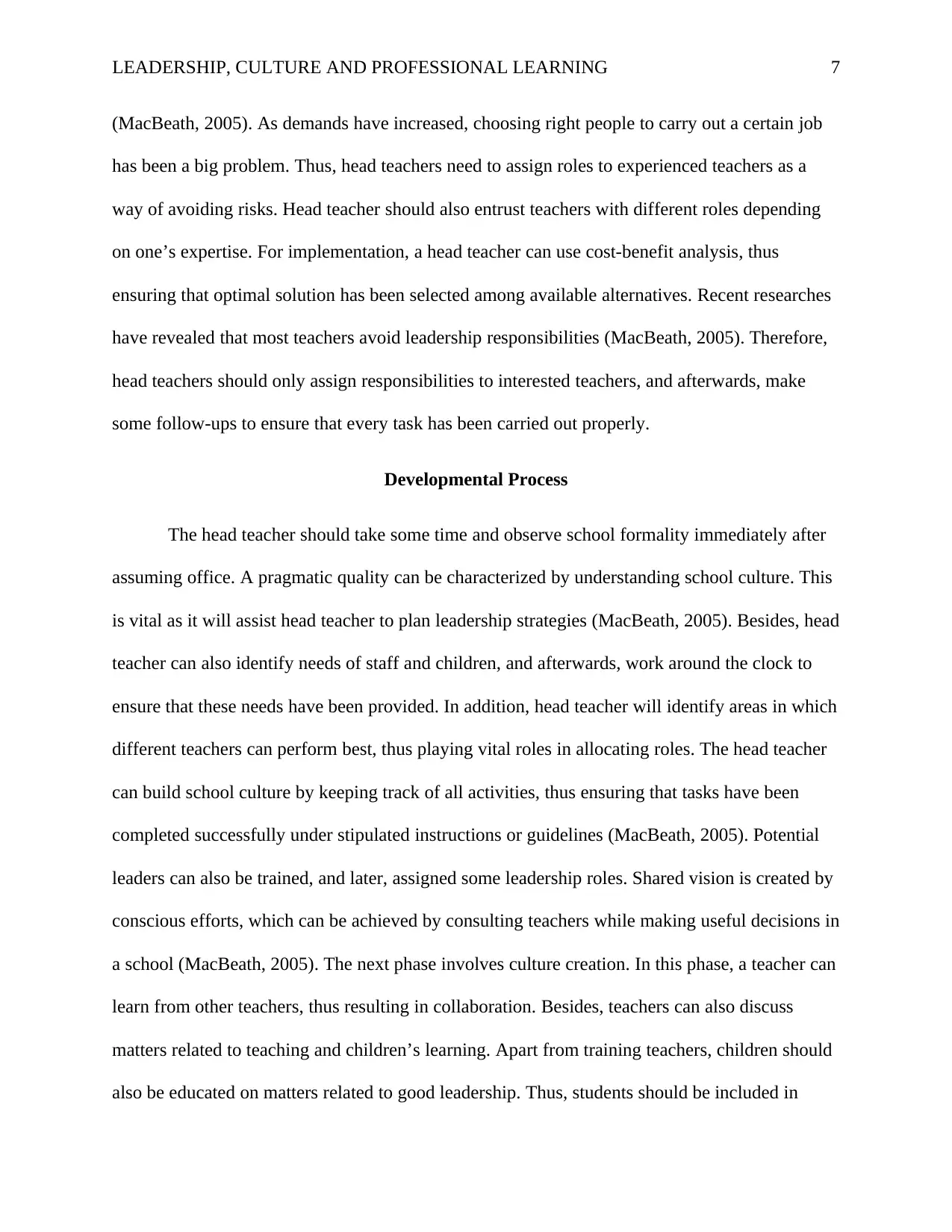
LEADERSHIP, CULTURE AND PROFESSIONAL LEARNING 7
(MacBeath, 2005). As demands have increased, choosing right people to carry out a certain job
has been a big problem. Thus, head teachers need to assign roles to experienced teachers as a
way of avoiding risks. Head teacher should also entrust teachers with different roles depending
on one’s expertise. For implementation, a head teacher can use cost-benefit analysis, thus
ensuring that optimal solution has been selected among available alternatives. Recent researches
have revealed that most teachers avoid leadership responsibilities (MacBeath, 2005). Therefore,
head teachers should only assign responsibilities to interested teachers, and afterwards, make
some follow-ups to ensure that every task has been carried out properly.
Developmental Process
The head teacher should take some time and observe school formality immediately after
assuming office. A pragmatic quality can be characterized by understanding school culture. This
is vital as it will assist head teacher to plan leadership strategies (MacBeath, 2005). Besides, head
teacher can also identify needs of staff and children, and afterwards, work around the clock to
ensure that these needs have been provided. In addition, head teacher will identify areas in which
different teachers can perform best, thus playing vital roles in allocating roles. The head teacher
can build school culture by keeping track of all activities, thus ensuring that tasks have been
completed successfully under stipulated instructions or guidelines (MacBeath, 2005). Potential
leaders can also be trained, and later, assigned some leadership roles. Shared vision is created by
conscious efforts, which can be achieved by consulting teachers while making useful decisions in
a school (MacBeath, 2005). The next phase involves culture creation. In this phase, a teacher can
learn from other teachers, thus resulting in collaboration. Besides, teachers can also discuss
matters related to teaching and children’s learning. Apart from training teachers, children should
also be educated on matters related to good leadership. Thus, students should be included in
(MacBeath, 2005). As demands have increased, choosing right people to carry out a certain job
has been a big problem. Thus, head teachers need to assign roles to experienced teachers as a
way of avoiding risks. Head teacher should also entrust teachers with different roles depending
on one’s expertise. For implementation, a head teacher can use cost-benefit analysis, thus
ensuring that optimal solution has been selected among available alternatives. Recent researches
have revealed that most teachers avoid leadership responsibilities (MacBeath, 2005). Therefore,
head teachers should only assign responsibilities to interested teachers, and afterwards, make
some follow-ups to ensure that every task has been carried out properly.
Developmental Process
The head teacher should take some time and observe school formality immediately after
assuming office. A pragmatic quality can be characterized by understanding school culture. This
is vital as it will assist head teacher to plan leadership strategies (MacBeath, 2005). Besides, head
teacher can also identify needs of staff and children, and afterwards, work around the clock to
ensure that these needs have been provided. In addition, head teacher will identify areas in which
different teachers can perform best, thus playing vital roles in allocating roles. The head teacher
can build school culture by keeping track of all activities, thus ensuring that tasks have been
completed successfully under stipulated instructions or guidelines (MacBeath, 2005). Potential
leaders can also be trained, and later, assigned some leadership roles. Shared vision is created by
conscious efforts, which can be achieved by consulting teachers while making useful decisions in
a school (MacBeath, 2005). The next phase involves culture creation. In this phase, a teacher can
learn from other teachers, thus resulting in collaboration. Besides, teachers can also discuss
matters related to teaching and children’s learning. Apart from training teachers, children should
also be educated on matters related to good leadership. Thus, students should be included in
Paraphrase This Document
Need a fresh take? Get an instant paraphrase of this document with our AI Paraphraser

LEADERSHIP, CULTURE AND PROFESSIONAL LEARNING 8
decision making process. On the other hand, phase 3 is related to ‘servant leadership’. Thus,
head teacher is required to support teachers. In this phase, trust in enhanced. To sustain
distributed leadership, a school must be supported by close friends as well as local authorities
(MacBeath, 2005).
ii. Instructional Leadership
This leadership model focuses on primary goals of education such as teaching and
learning (Hallinger, 2005). It includes behaviors such as cultural norms and curricular content
that contributes vastly to overall success of a school. In 80’s, it was recognized as one of the
principal’s roles. It includes the following; developing school goals, resources allocation,
evaluating teachers, curriculum management and enhancement of school climate (Hallinger,
2005).
School Leadership Constraints
Leading a school successfully is not an easy task. For instance, several scholars
questioned about the ability of principals to satisfy teachers and children’s’ needs. A research
revealed that few people supported adoption of instructional leadership model in secondary
schools. However, it was concluded that instructional leadership can play important roles in large
organizations. According to Hallinger (2005). Instructional Leadership and the School Principal:
A passing fancy that refuses to fade away. Leadership and Policy in Schools, 4:3, 221-239,
rational model is one of the characteristics of instructional leadership. It was perceived that
principal’s roles could lead to greater improvement. The following are some of the roles of
school principals; aligning teaching and monitoring progress (Hallinger, 2005).
decision making process. On the other hand, phase 3 is related to ‘servant leadership’. Thus,
head teacher is required to support teachers. In this phase, trust in enhanced. To sustain
distributed leadership, a school must be supported by close friends as well as local authorities
(MacBeath, 2005).
ii. Instructional Leadership
This leadership model focuses on primary goals of education such as teaching and
learning (Hallinger, 2005). It includes behaviors such as cultural norms and curricular content
that contributes vastly to overall success of a school. In 80’s, it was recognized as one of the
principal’s roles. It includes the following; developing school goals, resources allocation,
evaluating teachers, curriculum management and enhancement of school climate (Hallinger,
2005).
School Leadership Constraints
Leading a school successfully is not an easy task. For instance, several scholars
questioned about the ability of principals to satisfy teachers and children’s’ needs. A research
revealed that few people supported adoption of instructional leadership model in secondary
schools. However, it was concluded that instructional leadership can play important roles in large
organizations. According to Hallinger (2005). Instructional Leadership and the School Principal:
A passing fancy that refuses to fade away. Leadership and Policy in Schools, 4:3, 221-239,
rational model is one of the characteristics of instructional leadership. It was perceived that
principal’s roles could lead to greater improvement. The following are some of the roles of
school principals; aligning teaching and monitoring progress (Hallinger, 2005).
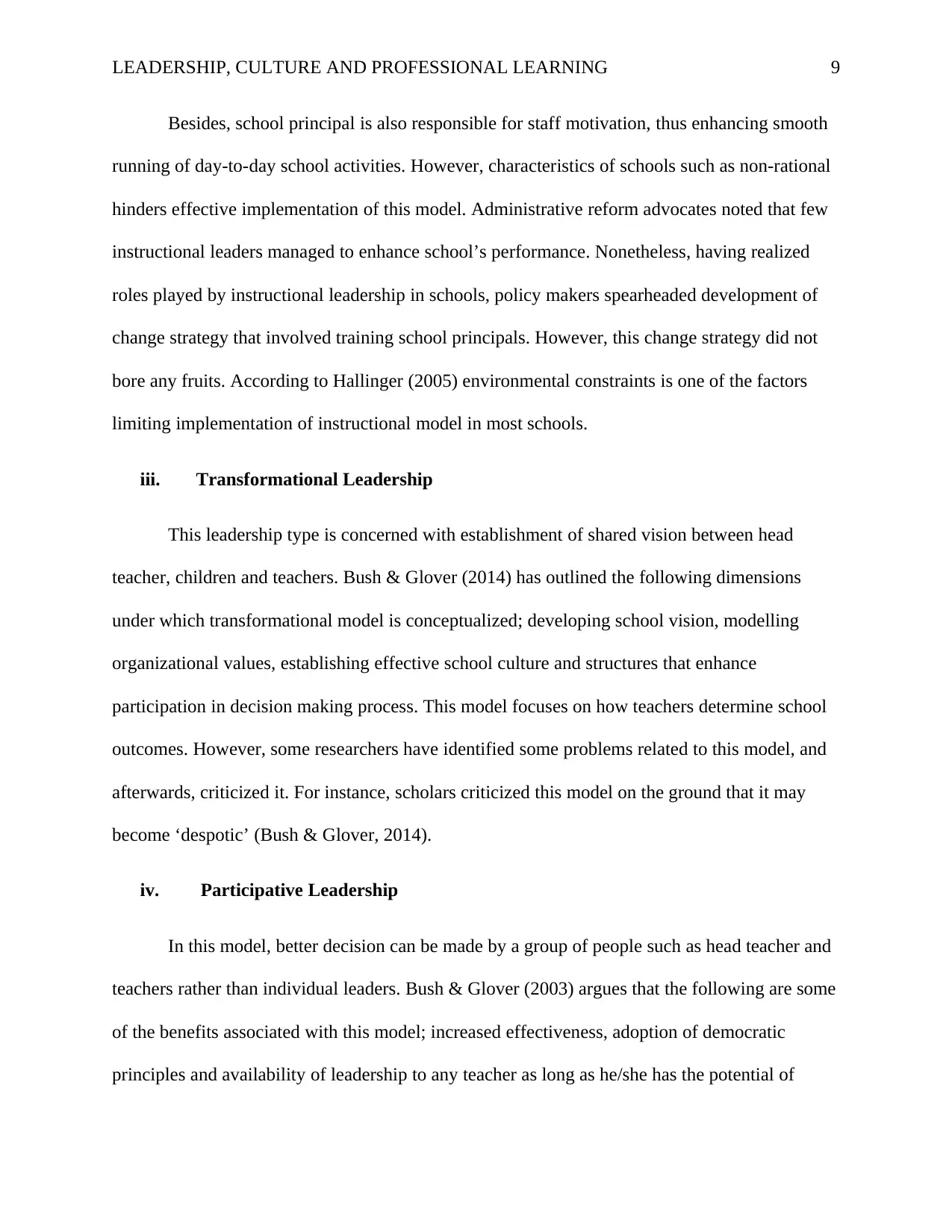
LEADERSHIP, CULTURE AND PROFESSIONAL LEARNING 9
Besides, school principal is also responsible for staff motivation, thus enhancing smooth
running of day-to-day school activities. However, characteristics of schools such as non-rational
hinders effective implementation of this model. Administrative reform advocates noted that few
instructional leaders managed to enhance school’s performance. Nonetheless, having realized
roles played by instructional leadership in schools, policy makers spearheaded development of
change strategy that involved training school principals. However, this change strategy did not
bore any fruits. According to Hallinger (2005) environmental constraints is one of the factors
limiting implementation of instructional model in most schools.
iii. Transformational Leadership
This leadership type is concerned with establishment of shared vision between head
teacher, children and teachers. Bush & Glover (2014) has outlined the following dimensions
under which transformational model is conceptualized; developing school vision, modelling
organizational values, establishing effective school culture and structures that enhance
participation in decision making process. This model focuses on how teachers determine school
outcomes. However, some researchers have identified some problems related to this model, and
afterwards, criticized it. For instance, scholars criticized this model on the ground that it may
become ‘despotic’ (Bush & Glover, 2014).
iv. Participative Leadership
In this model, better decision can be made by a group of people such as head teacher and
teachers rather than individual leaders. Bush & Glover (2003) argues that the following are some
of the benefits associated with this model; increased effectiveness, adoption of democratic
principles and availability of leadership to any teacher as long as he/she has the potential of
Besides, school principal is also responsible for staff motivation, thus enhancing smooth
running of day-to-day school activities. However, characteristics of schools such as non-rational
hinders effective implementation of this model. Administrative reform advocates noted that few
instructional leaders managed to enhance school’s performance. Nonetheless, having realized
roles played by instructional leadership in schools, policy makers spearheaded development of
change strategy that involved training school principals. However, this change strategy did not
bore any fruits. According to Hallinger (2005) environmental constraints is one of the factors
limiting implementation of instructional model in most schools.
iii. Transformational Leadership
This leadership type is concerned with establishment of shared vision between head
teacher, children and teachers. Bush & Glover (2014) has outlined the following dimensions
under which transformational model is conceptualized; developing school vision, modelling
organizational values, establishing effective school culture and structures that enhance
participation in decision making process. This model focuses on how teachers determine school
outcomes. However, some researchers have identified some problems related to this model, and
afterwards, criticized it. For instance, scholars criticized this model on the ground that it may
become ‘despotic’ (Bush & Glover, 2014).
iv. Participative Leadership
In this model, better decision can be made by a group of people such as head teacher and
teachers rather than individual leaders. Bush & Glover (2003) argues that the following are some
of the benefits associated with this model; increased effectiveness, adoption of democratic
principles and availability of leadership to any teacher as long as he/she has the potential of
⊘ This is a preview!⊘
Do you want full access?
Subscribe today to unlock all pages.

Trusted by 1+ million students worldwide
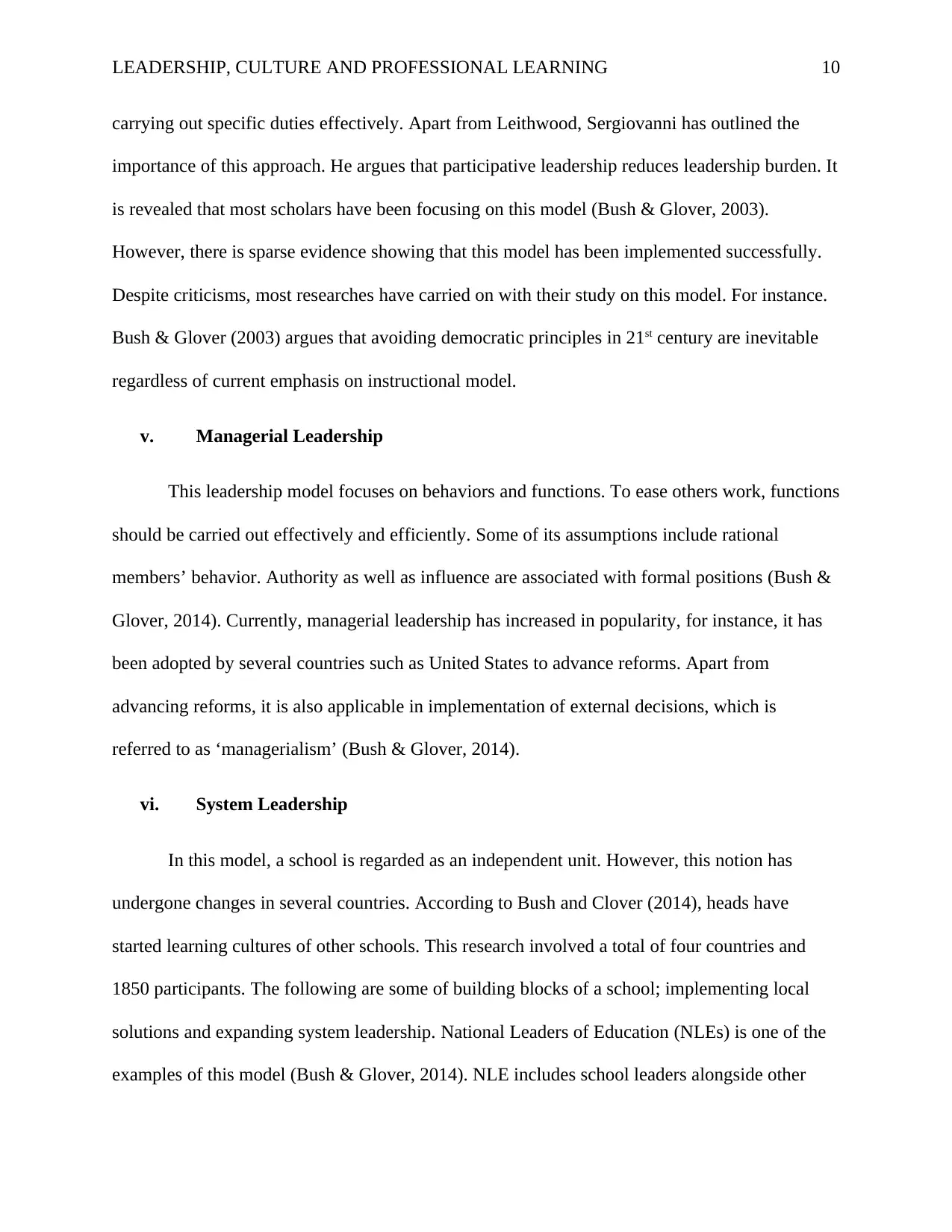
LEADERSHIP, CULTURE AND PROFESSIONAL LEARNING 10
carrying out specific duties effectively. Apart from Leithwood, Sergiovanni has outlined the
importance of this approach. He argues that participative leadership reduces leadership burden. It
is revealed that most scholars have been focusing on this model (Bush & Glover, 2003).
However, there is sparse evidence showing that this model has been implemented successfully.
Despite criticisms, most researches have carried on with their study on this model. For instance.
Bush & Glover (2003) argues that avoiding democratic principles in 21st century are inevitable
regardless of current emphasis on instructional model.
v. Managerial Leadership
This leadership model focuses on behaviors and functions. To ease others work, functions
should be carried out effectively and efficiently. Some of its assumptions include rational
members’ behavior. Authority as well as influence are associated with formal positions (Bush &
Glover, 2014). Currently, managerial leadership has increased in popularity, for instance, it has
been adopted by several countries such as United States to advance reforms. Apart from
advancing reforms, it is also applicable in implementation of external decisions, which is
referred to as ‘managerialism’ (Bush & Glover, 2014).
vi. System Leadership
In this model, a school is regarded as an independent unit. However, this notion has
undergone changes in several countries. According to Bush and Clover (2014), heads have
started learning cultures of other schools. This research involved a total of four countries and
1850 participants. The following are some of building blocks of a school; implementing local
solutions and expanding system leadership. National Leaders of Education (NLEs) is one of the
examples of this model (Bush & Glover, 2014). NLE includes school leaders alongside other
carrying out specific duties effectively. Apart from Leithwood, Sergiovanni has outlined the
importance of this approach. He argues that participative leadership reduces leadership burden. It
is revealed that most scholars have been focusing on this model (Bush & Glover, 2003).
However, there is sparse evidence showing that this model has been implemented successfully.
Despite criticisms, most researches have carried on with their study on this model. For instance.
Bush & Glover (2003) argues that avoiding democratic principles in 21st century are inevitable
regardless of current emphasis on instructional model.
v. Managerial Leadership
This leadership model focuses on behaviors and functions. To ease others work, functions
should be carried out effectively and efficiently. Some of its assumptions include rational
members’ behavior. Authority as well as influence are associated with formal positions (Bush &
Glover, 2014). Currently, managerial leadership has increased in popularity, for instance, it has
been adopted by several countries such as United States to advance reforms. Apart from
advancing reforms, it is also applicable in implementation of external decisions, which is
referred to as ‘managerialism’ (Bush & Glover, 2014).
vi. System Leadership
In this model, a school is regarded as an independent unit. However, this notion has
undergone changes in several countries. According to Bush and Clover (2014), heads have
started learning cultures of other schools. This research involved a total of four countries and
1850 participants. The following are some of building blocks of a school; implementing local
solutions and expanding system leadership. National Leaders of Education (NLEs) is one of the
examples of this model (Bush & Glover, 2014). NLE includes school leaders alongside other
Paraphrase This Document
Need a fresh take? Get an instant paraphrase of this document with our AI Paraphraser
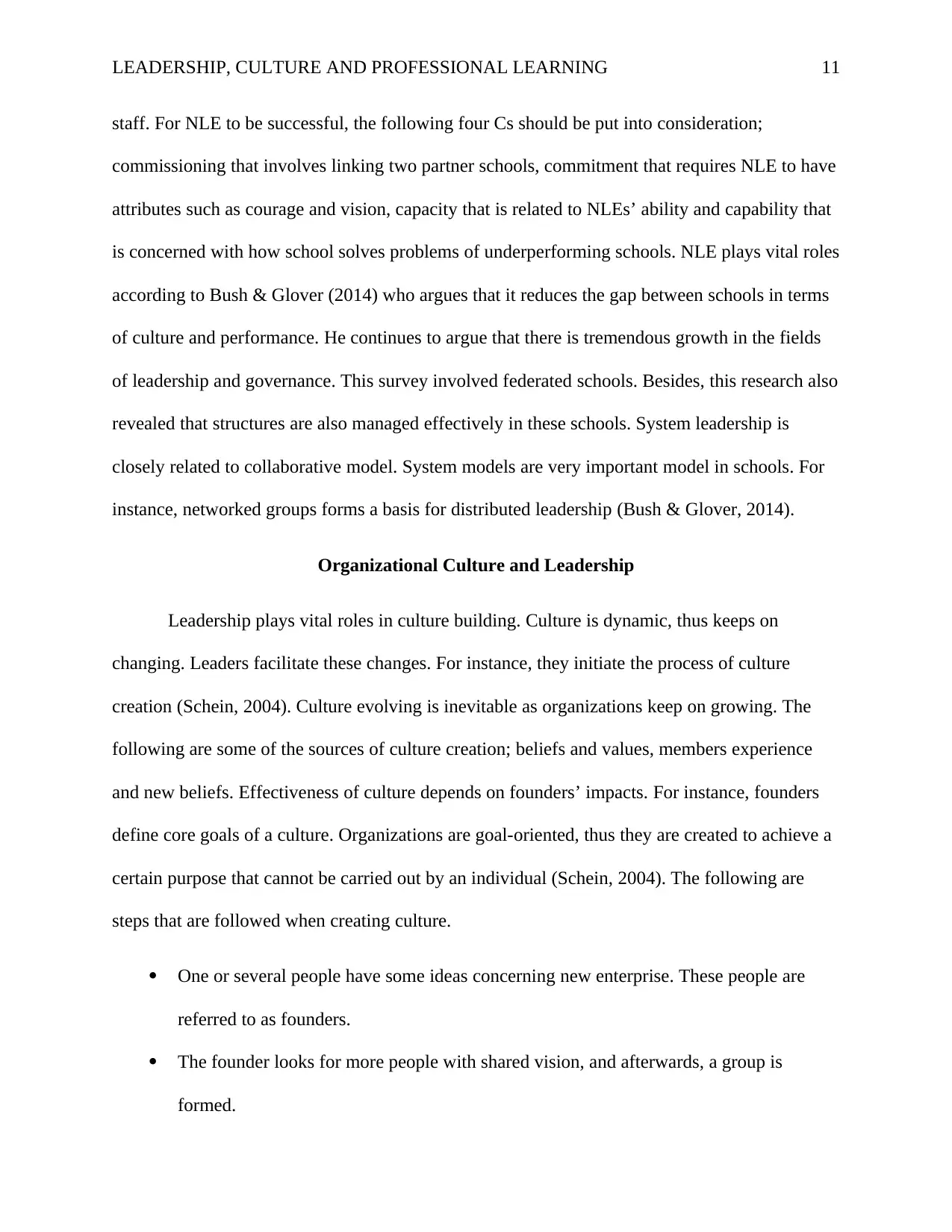
LEADERSHIP, CULTURE AND PROFESSIONAL LEARNING 11
staff. For NLE to be successful, the following four Cs should be put into consideration;
commissioning that involves linking two partner schools, commitment that requires NLE to have
attributes such as courage and vision, capacity that is related to NLEs’ ability and capability that
is concerned with how school solves problems of underperforming schools. NLE plays vital roles
according to Bush & Glover (2014) who argues that it reduces the gap between schools in terms
of culture and performance. He continues to argue that there is tremendous growth in the fields
of leadership and governance. This survey involved federated schools. Besides, this research also
revealed that structures are also managed effectively in these schools. System leadership is
closely related to collaborative model. System models are very important model in schools. For
instance, networked groups forms a basis for distributed leadership (Bush & Glover, 2014).
Organizational Culture and Leadership
Leadership plays vital roles in culture building. Culture is dynamic, thus keeps on
changing. Leaders facilitate these changes. For instance, they initiate the process of culture
creation (Schein, 2004). Culture evolving is inevitable as organizations keep on growing. The
following are some of the sources of culture creation; beliefs and values, members experience
and new beliefs. Effectiveness of culture depends on founders’ impacts. For instance, founders
define core goals of a culture. Organizations are goal-oriented, thus they are created to achieve a
certain purpose that cannot be carried out by an individual (Schein, 2004). The following are
steps that are followed when creating culture.
One or several people have some ideas concerning new enterprise. These people are
referred to as founders.
The founder looks for more people with shared vision, and afterwards, a group is
formed.
staff. For NLE to be successful, the following four Cs should be put into consideration;
commissioning that involves linking two partner schools, commitment that requires NLE to have
attributes such as courage and vision, capacity that is related to NLEs’ ability and capability that
is concerned with how school solves problems of underperforming schools. NLE plays vital roles
according to Bush & Glover (2014) who argues that it reduces the gap between schools in terms
of culture and performance. He continues to argue that there is tremendous growth in the fields
of leadership and governance. This survey involved federated schools. Besides, this research also
revealed that structures are also managed effectively in these schools. System leadership is
closely related to collaborative model. System models are very important model in schools. For
instance, networked groups forms a basis for distributed leadership (Bush & Glover, 2014).
Organizational Culture and Leadership
Leadership plays vital roles in culture building. Culture is dynamic, thus keeps on
changing. Leaders facilitate these changes. For instance, they initiate the process of culture
creation (Schein, 2004). Culture evolving is inevitable as organizations keep on growing. The
following are some of the sources of culture creation; beliefs and values, members experience
and new beliefs. Effectiveness of culture depends on founders’ impacts. For instance, founders
define core goals of a culture. Organizations are goal-oriented, thus they are created to achieve a
certain purpose that cannot be carried out by an individual (Schein, 2004). The following are
steps that are followed when creating culture.
One or several people have some ideas concerning new enterprise. These people are
referred to as founders.
The founder looks for more people with shared vision, and afterwards, a group is
formed.
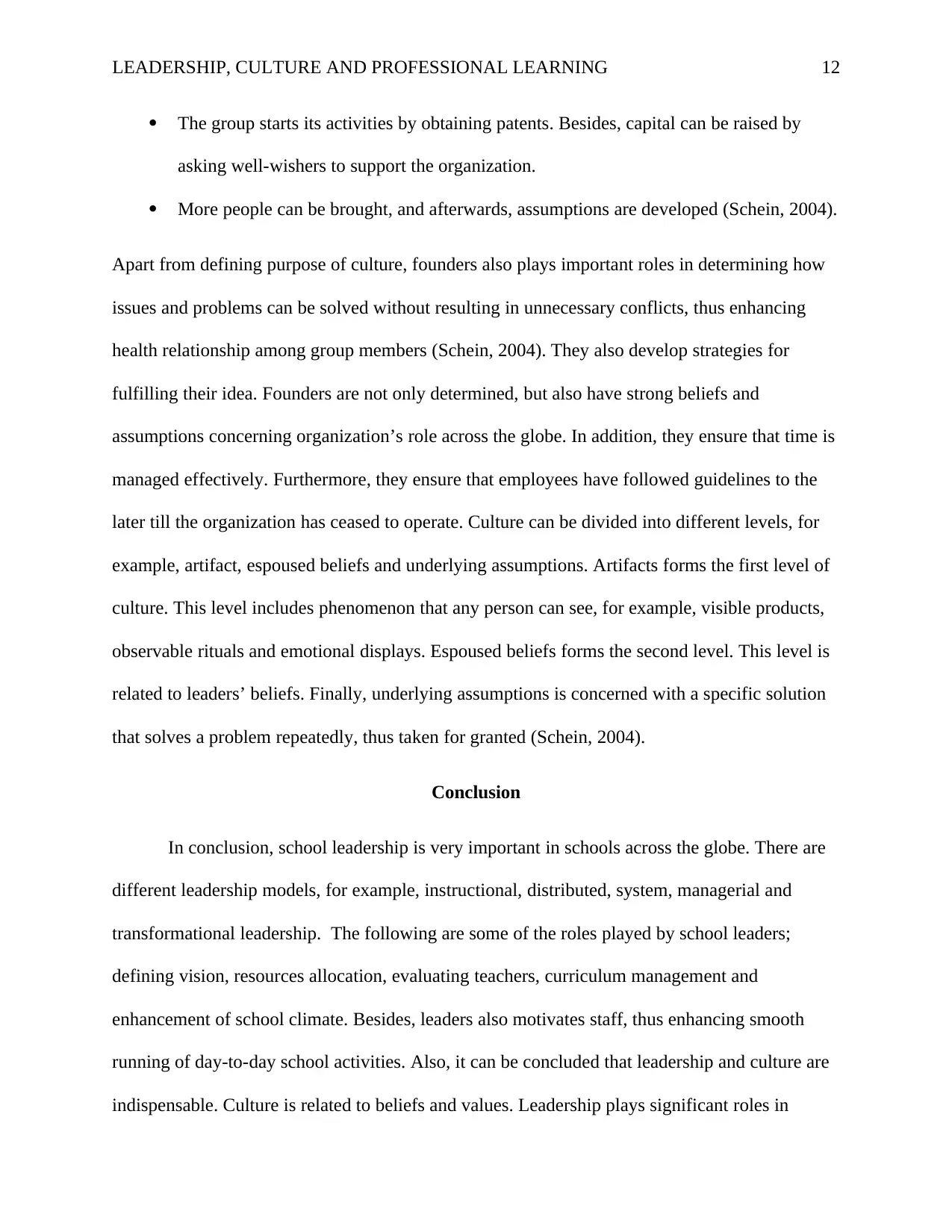
LEADERSHIP, CULTURE AND PROFESSIONAL LEARNING 12
The group starts its activities by obtaining patents. Besides, capital can be raised by
asking well-wishers to support the organization.
More people can be brought, and afterwards, assumptions are developed (Schein, 2004).
Apart from defining purpose of culture, founders also plays important roles in determining how
issues and problems can be solved without resulting in unnecessary conflicts, thus enhancing
health relationship among group members (Schein, 2004). They also develop strategies for
fulfilling their idea. Founders are not only determined, but also have strong beliefs and
assumptions concerning organization’s role across the globe. In addition, they ensure that time is
managed effectively. Furthermore, they ensure that employees have followed guidelines to the
later till the organization has ceased to operate. Culture can be divided into different levels, for
example, artifact, espoused beliefs and underlying assumptions. Artifacts forms the first level of
culture. This level includes phenomenon that any person can see, for example, visible products,
observable rituals and emotional displays. Espoused beliefs forms the second level. This level is
related to leaders’ beliefs. Finally, underlying assumptions is concerned with a specific solution
that solves a problem repeatedly, thus taken for granted (Schein, 2004).
Conclusion
In conclusion, school leadership is very important in schools across the globe. There are
different leadership models, for example, instructional, distributed, system, managerial and
transformational leadership. The following are some of the roles played by school leaders;
defining vision, resources allocation, evaluating teachers, curriculum management and
enhancement of school climate. Besides, leaders also motivates staff, thus enhancing smooth
running of day-to-day school activities. Also, it can be concluded that leadership and culture are
indispensable. Culture is related to beliefs and values. Leadership plays significant roles in
The group starts its activities by obtaining patents. Besides, capital can be raised by
asking well-wishers to support the organization.
More people can be brought, and afterwards, assumptions are developed (Schein, 2004).
Apart from defining purpose of culture, founders also plays important roles in determining how
issues and problems can be solved without resulting in unnecessary conflicts, thus enhancing
health relationship among group members (Schein, 2004). They also develop strategies for
fulfilling their idea. Founders are not only determined, but also have strong beliefs and
assumptions concerning organization’s role across the globe. In addition, they ensure that time is
managed effectively. Furthermore, they ensure that employees have followed guidelines to the
later till the organization has ceased to operate. Culture can be divided into different levels, for
example, artifact, espoused beliefs and underlying assumptions. Artifacts forms the first level of
culture. This level includes phenomenon that any person can see, for example, visible products,
observable rituals and emotional displays. Espoused beliefs forms the second level. This level is
related to leaders’ beliefs. Finally, underlying assumptions is concerned with a specific solution
that solves a problem repeatedly, thus taken for granted (Schein, 2004).
Conclusion
In conclusion, school leadership is very important in schools across the globe. There are
different leadership models, for example, instructional, distributed, system, managerial and
transformational leadership. The following are some of the roles played by school leaders;
defining vision, resources allocation, evaluating teachers, curriculum management and
enhancement of school climate. Besides, leaders also motivates staff, thus enhancing smooth
running of day-to-day school activities. Also, it can be concluded that leadership and culture are
indispensable. Culture is related to beliefs and values. Leadership plays significant roles in
⊘ This is a preview!⊘
Do you want full access?
Subscribe today to unlock all pages.

Trusted by 1+ million students worldwide
1 out of 15
Related Documents
Your All-in-One AI-Powered Toolkit for Academic Success.
+13062052269
info@desklib.com
Available 24*7 on WhatsApp / Email
![[object Object]](/_next/static/media/star-bottom.7253800d.svg)
Unlock your academic potential
Copyright © 2020–2026 A2Z Services. All Rights Reserved. Developed and managed by ZUCOL.





